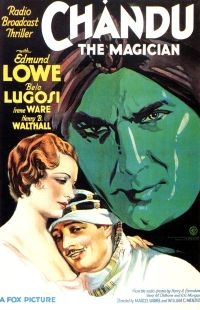
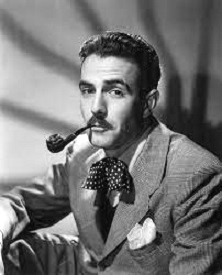 Chandu, the Magician (1932-35, 1948-50) aired “The Village of Thieves” on February 10, 1949 as the 2nd of the 13 half-hour episodes that began in February to begin the 1949 season. It ran until the end of April when the summer hiatus would intervene, the show picking up again in November with its final 6 episodes that would end the year with its Christmas Eve show. The show’s final season (consisting of another 6 episodes) would run from July 26th to August 30th, 1950. This is the 5th episode of Chandu we’ve offered since the first in April of 2023 and the first since January of this year, 2025.
Chandu, the Magician (1932-35, 1948-50) aired “The Village of Thieves” on February 10, 1949 as the 2nd of the 13 half-hour episodes that began in February to begin the 1949 season. It ran until the end of April when the summer hiatus would intervene, the show picking up again in November with its final 6 episodes that would end the year with its Christmas Eve show. The show’s final season (consisting of another 6 episodes) would run from July 26th to August 30th, 1950. This is the 5th episode of Chandu we’ve offered since the first in April of 2023 and the first since January of this year, 2025.
The first run (1932-35) consisted of daily 15-minute episodes that became popular very quickly, so much so that a 1932 film soon followed the radio adventures of Chandu. The idea behind Chandu the Magician stemmed from the public’s interest at the time with Eastern mysticism and the occult. The Chandu character’s fictional real life name is Frank Chandler. Chandler has spent many years in the Orient studying the mystic arts and is now adept at astral projection, conjuring illusions, and teleportation among other magical abilities he uses when necessary. If this sounds like a familiar set of superpowers it was, witness magazine and radio close contemporaries like the Shadow or Mandrake the Magician—though Chandu on radio was the first. The original story arc sees Chandu chasing after the evil Roxor, who has kidnapped the husband of Chandu’s sister, Dorothy Regent. Chandu and his sister travel to all sorts of exotic locales in search of her husband (who was thought to have disappeared in a shipwreck but later to have disappeared at the hands of Roxor). Roxor, as all truly evil villains are, is bent on conquering the 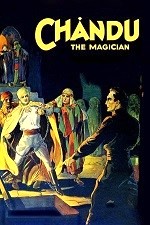 world and will stop at nothing to accomplish his egomaniacal ends. For the original 1932 movie, actor Edmund Lowe played Chandu, while none other than Bela Lugosi took the role of Roxor. For the 1934 sequel, however, in a surprising role reversal Lugosi was honored with the role of Chandu.
world and will stop at nothing to accomplish his egomaniacal ends. For the original 1932 movie, actor Edmund Lowe played Chandu, while none other than Bela Lugosi took the role of Roxor. For the 1934 sequel, however, in a surprising role reversal Lugosi was honored with the role of Chandu.
A crucial bit of the history of the show would be incomplete without mentioning that a great part of the radio show’s success was due to a young woman by the name of Vera Oldham, a former office girl who proved good on her aspirations to write. After the radio series ended in 1935 and the Chandu films were long over, Chandu was resurrected on radio in 1948, with the former story arc refurbished and updated (even bringing back Oldham to touch up the scripts), continuing Chandu’s travels to mysterious and little known parts of the world (the fabled land of Lemuria for one), and gifting him with a love interest of surpassing beauty in the character of the Egyptian princess Nadji.
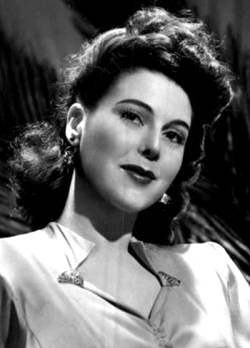
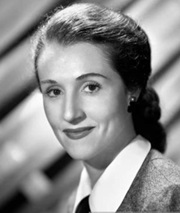 For the 1948-50 radio revival, the episodes from June of 1948 through the end of January 1949 were daily 15-minute episodes, then from February of 1949 through the final show on September 6, 1950 Chandu would become full half hour, self-contained stories, of which this week’s episode is one. Tom Collins (1913-73, photo top right) would become the new voice of Chandu, Irene Tedrow (1907-1995, photo at right) played his sister Dorothy, and film actress Veola Vonn (1918-1995, photo at left) was Princess Nadji. While Dorothy appears in this episode, Princess Nadji does not. Besides her dual careers in radio and film, Tedrow would also make a name for herself in television, appearing in dozens of shows, a very few among them being Dennis the Menace (1959-63, 26 episodes as Mrs. Lucy Elkins), Dragnet, Leave it to Beaver, The Twilight Zone (episode “Walking Distance” from October 30, 1959; ranked as the 9th best TZ episode of all time), Perry Mason, Wagon Train, Bonanza, The Andy Griffith Show, The Fugitive, Hogan’s Heroes, Kung Fu, Magnum P.I., L.A. Law, and a veritable host of others. In 1939 Tedrow married William Kent, a refugee who came to the United States to escape Nazi Germany. He passed away in 1974. Tedrow died on March 10, 1995 in Hollywood from complications arising from a stroke. She was 87.
For the 1948-50 radio revival, the episodes from June of 1948 through the end of January 1949 were daily 15-minute episodes, then from February of 1949 through the final show on September 6, 1950 Chandu would become full half hour, self-contained stories, of which this week’s episode is one. Tom Collins (1913-73, photo top right) would become the new voice of Chandu, Irene Tedrow (1907-1995, photo at right) played his sister Dorothy, and film actress Veola Vonn (1918-1995, photo at left) was Princess Nadji. While Dorothy appears in this episode, Princess Nadji does not. Besides her dual careers in radio and film, Tedrow would also make a name for herself in television, appearing in dozens of shows, a very few among them being Dennis the Menace (1959-63, 26 episodes as Mrs. Lucy Elkins), Dragnet, Leave it to Beaver, The Twilight Zone (episode “Walking Distance” from October 30, 1959; ranked as the 9th best TZ episode of all time), Perry Mason, Wagon Train, Bonanza, The Andy Griffith Show, The Fugitive, Hogan’s Heroes, Kung Fu, Magnum P.I., L.A. Law, and a veritable host of others. In 1939 Tedrow married William Kent, a refugee who came to the United States to escape Nazi Germany. He passed away in 1974. Tedrow died on March 10, 1995 in Hollywood from complications arising from a stroke. She was 87.
“The Village of Thieves” is where Chandu finds himself for this adventure, amidst the narrow, shadowy streets of Cairo. He becomes aware of a certain individual, an employee of the British government working for the foreign office no less, who has been abducted by a notorious band of thieves. Through his local network of native “friends” Chandu learns the man is held in a secret desert location, but that a plan to set him free may be harder than it first appears given the nature of the bloodthirsty cutthroats. Enter one of the artifacts Chandu has brought with him following his years of mystic training in India, a special crystal ball able to show him visions as needed when mentally activated. Not only does Chandu discover the whereabouts of the captured British official, but he coincidentally finds out the real power behind the tribe of thieves is none other than his arch nemesis Roxor. Continuous action of one kind or another seems to be the name of the game in this episode, so don’t get too comfortable during your brief visit to “The Village of Thieves.”
Play Time: 31:10
{“The Village of Thieves” aired on a cold Thursday night in early February of 1949. The neighborhood gang weathered through Friday’s seemingly never-ending school day, the only thing on their minds after the final bell had rung, setting them free for the weekend, was the quick dash to the nearby newsstand where more tales of adventure awaited them. Detective Tales (1935-53) began and ran as a monthly for almost its entire existence. From 1935 through January of 1948 it touted 12 stories per issue on every cover. From February 1948 through December 1949 that number grew to 15 stories per issue. From 1950 until its demise with the August 1953 issue the cover dropped all mention of the number of stories in any given issue. A highly popular detective pulp, it ran for 18 years (all but the last 3 as a monthly) and managed over 200 issues. It was a monthly in 1949. Doc Savage (1933-49) was created to hopefully cash in on the popularity of The Shadow magazine begun in 1931. While the Shadow character worked alone, Doc Savage, was a genius scientist, explorer, detective, and warrior who had help from a number of aides who were expert in a number of areas that complemented Doc’s areas of expertise. There was “Monk” Mayfair, a chemist; “Ham” Brooks, a lawyer; “Renny” Renwick, a construction engineer; “Long Tom” Roberts, an electrical engineer; and “Johnny” Littlejohn, an archaeologist and geologist. Surrounded by his expert team, also devoted to Doc’s cause to “right wrongs and punish evildoers,” Doc’s adventures were wide-ranging as well as local, taking him to far parts of the globe to battle evil in all its guises. His exploits were so popular that they spawned his adventures in film, comics, and radio. His magazine adventures were monthly through 1946. 1947 & 1948 saw his magazine publish on a bi-monthly basis, and with its final year it became a quarterly, finishing with but 3 issues. The issue featured below was its third to last. Fighting Western (1945-50) ran on no set schedule, publishing anywhere from 3 to 8 issues a year on a scattershot basis. Nevertheless, the issues making it to newsstands promised another setting for the action-packed stories its young male audience found appealing (and as with many another pulp magazine in other genres, a buxom female on many of its dynamic covers–fully or partially clad–didn’t exactly hurt sales). The issue below was the first of four it managed in 1949.}
[Left: Detective Tales, 2/49 – Center: Doc Savage, Winter/49 – Right: Fighting Western, 1/49]
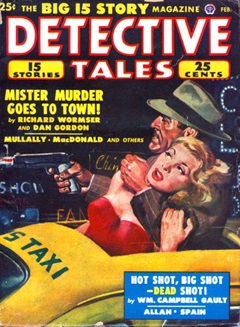
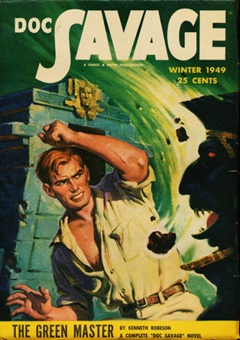
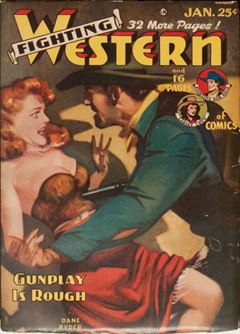
To view the entire list of weekly Old Time Radio episodes at Tangent Online, click here.